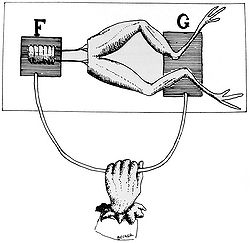Count Alessandro Volta
Work by Beiwen Liu
Alessandro Volta was an Italian scientist who invented the first battery that produced a steady current. The term "Volt" was named after him.
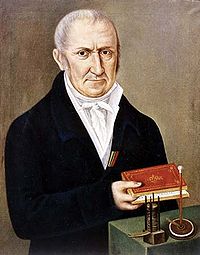
Biography
Early Life and Works
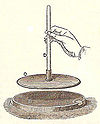
Alessandro Giuseppe Antonio Anastasio Volta was a man of many scientific interests. He was considered a physicist, a chemist, and a pioneer of the study of electricity and power. Volta was born in 1745 in Como, Italy and died in 1827. In 1774, he started his career as a physics professor at the Royal School in Como.
By studying electricity on the side, Volta had improved and popularized a device called the Electrophorus, which is a simple capacitive generator that produces electrostatic charge through electrostatic induction. In simple terms, this device generated static electricity. Volta continued to study and experiment with atmospheric electricity, and in 1776, he discovered and found ways to isolate methane gas in the atmosphere. In 1779, Volta was appointed the chair of physics at the University of Pavia.
Mid-Life and Inventions
In 1791, Volta's friend Luigi Galvani, a physicist who also studied electricity, had introduced to him an experiment done with frogs. Volta saw that the contact of two different metals with a particular muscle from the frog created an electrical current. Many interpretations arose as Galvani had named it as "animal electricity", where he believed that electricity could be generated in living tissue, and Volta had named it as "metallic electricity", where he believed that the frog's muscle only served as a conductor when the current flowed between the metals.
Volta came to his conclusions about "metallic electricity" through his experimentation with metals alone as he used metal disks and detected weak flow of electricity simply by placing them on his tongue. As a result, he realized that animal tissue was not a requirement for metal to create a current and that the animal tissue, as well as his tongue, served as conductors.
In the year 1800, Volta had announced his first invention, known today as the electric battery. At the time, his invention was known as and composed of a concept called the "Voltaic pile". This voltaic pile was the first electrical battery that could provide an electrical current to a circuit. This mechanism consisted of alternating disks of zinc, copper, or silver that was divided by paper, cloth, or cardboard soaked in salt water or sodium hydroxide. The name "Voltaic pile" simply described the physical aspects as it consisted of stacking pairs of alternating disks. With these alternating copper and zinc discs, Volta was able to increase the electrolyte conductivity of the device. When the top and bottom surfaces are connected by wire, an electric current flows through the voltaic pile and the wire itself. This idea formed the basis of all modern wet-cell batteries because it created a new generation of self-sustained electrical current.
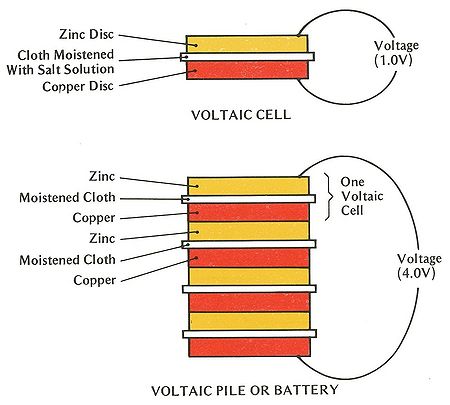
Many new concepts were formed due to Volta's battery: William Nicholson and Anthony Carlisle were able to use the voltaic pile to decompose water into hydrogen and oxygen. With the study of chemistry in their field, they were able to discover the electrolysis of water. Humphry Davy discovered that chemical reaction drove electric current through a circuit containing a single voltaic cell. He was able to demonstrate carbon arc discharge which isolated five new elements currently known on the periodic table as barium, calcium, boron, strontium, and magnesium. William Hyde Wollaston discovered the similarities between electricity generated by the voltaic pile and electricity generated by friction.
The following chemical equations represent the chemical reactions in the voltaic cell:
- Zinc:
- Zn → Zn2+ + 2e−
- Sulfuric acid:
- 2H+ + 2e− → H2
Positively charged hydrogen ions capture electrons from copper and makes hydrogen gas, H2. This would cause the zinc to become negative and the copper to be positive. Copper does not react and it only serves as an electrode for the electric current.
Scientific Contribution
Volta's Law of Capacitance
Although it was Ewald Georg von Kleist who discovered the idea of Capacitance, Volta had already established certain ideas related to capacitance. As he studied both electric potential and charge, he realized that for any given object, these two variables changed proportionally. As a result, Volta clarified the concept of electrical tension (voltage) and formulated a relation between charge, tension, and capacity.
Voltage (named after Volta) is the term used now to describe the amount of electrical force necessary to drive an electric current between two points. Voltage can be measured in electric potential energy per unit charge, or joules per coulomb. Volta's law of capacitance is ultimately the fundamental concepts of voltage.
Potential Difference
It is also very important to understand the difference between voltage and volts in this class: Voltage is a term that describes the electric potential concept, while volts is the unit (joules per coulomb) measurement of voltage.
To calculate the potential difference, we define an equation to be : [math]\displaystyle{ \Delta V }[/math] = -[math]\displaystyle{ \vec{E} }[/math]●[math]\displaystyle{ \Delta \vec{x} }[/math]
[math]\displaystyle{ \Delta V }[/math] is the potential difference
[math]\displaystyle{ \vec{E} }[/math] is the electric field
[math]\displaystyle{ \Delta \vec{x} }[/math] is the path where we want to measure the potential difference
Note that there is a dot product, and this means that we are looking for components of the electric field solely parallel to our path. There is also a negative sign in this equation; this signifies that the sign of voltage is opposite to the direction that the electric field follows a path. If the electric field follows the path in the same direction, then [math]\displaystyle{ \Delta V }[/math] is negative, and if the electric field follows the path in the opposite direction, [math]\displaystyle{ \Delta V }[/math] is positive.
Electromotive Force (EMF)
Because Volta invented the first battery, he studied the electromotive force of such battery. Because voltage and volts are both named after him, the concept of EMF is a term named after what he had studied. EMF stands for electromotive force and this is what makes the electrons move from atom to atom; this also represents the source voltage of a circuit. Voltage is a more general term and can be applied to the voltage drop between different points along a circuit.
The following diagram represents how voltage and emf can be applied to other concepts in physics. Alessandro Volta has made an enormous impact in our fundamental understanding of physics, and specifically the electric aspect of science.
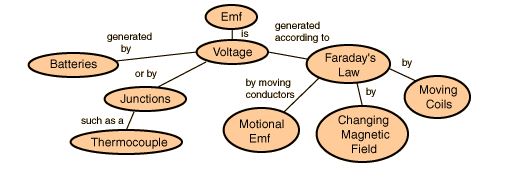
Application of Voltage
Putting voltage into perspective: The following examples are just some common objects we encounter with a certain amount of voltage that we should all be aware of.
Single-cell non-rechargeable batteries (AAA, AA, C, D): 1.5 V
Single-cell rechargeable batteries: 1.2 V
A car’s electrical system: 12 V
Commercial truck: 24 V
Household wall sockets (North America): 120 V
Subway system “third rail”: 600-750 V
Other Inventions
All of the following inventions were either developed or majorly contributed by Volta
Electroscope
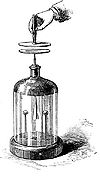
A device used to detect the presence and the magnitude of a charge. The design is usually constructed with either a metal plate or sphere at the top with gold leaves hanging at the bottom of the plate. When a charged object is brought near the device, the leaves on the bottom will spread apart. The greater the magnitude of the charge, the greater the leaves will spread apart. While the electroscope we see today is invented by Jean-Antoine Nollet, Volta actually first invented the condensing electroscope that only detected the presence of negative charges in water vapor or in the smoke of burning coal.
Eudiometer
A device that measures the oxygen concentration in the air around it by mixing it with hydrogen and burning it.
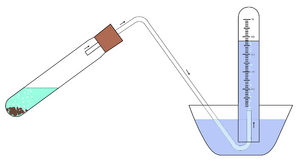
Electrostatic Pistol
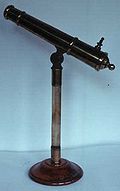
This invention started as an attempt at building a new form of weapon. The gun consists of a glass container in the shape of a pistol sealed with tap, and inside, a spark fires a combination of hydrogen and oxygen. The pistol was designed off of the Eudiometer.
Condenser
The condenser, also known as the capacitor we use today, is a device that stores electrical charge. It was originally developed by Ewald Georg von Kleist, but he would not have attained his position, without Volta's exposure to circuits and batteries. It consists of two places that are made of electrically conducting material and separated by nonconducting material. If voltage is applied to this device, the plates will polarize as one will become positive and the other negative. This applied voltage remains charged in the capacitor even after the removal of the applied voltage, and the presence of the electric charge induces an electrical potential between the plates.
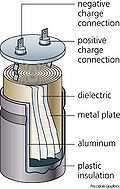
See also
Further reading
The Investigations and Inventions of Volta Volta: Science and Culture in the Age of Enlightenment. Giuliano Pancaldi. Princeton University Press, 2003.
http://www.americanscientist.org/bookshelf/pub/the-investigations-and-inventions-of-volta
External links
https://www.youtube.com/watch?v=c_0N-0lfxpE
https://www.youtube.com/watch?v=edMN7P5oCaY
References
http://www.britannica.com/biography/Alessandro-Volta
http://inventors.about.com/od/utstartinventors/a/Alessandro_Volta.htm
http://www.corrosion-doctors.org/Biographies/VoltaBio.htm
http://www.daviddarling.info/encyclopedia/E/electrophorus.html
http://enlightenme.com/voltage/
http://www.chemistryexplained.com/Va-Z/Volta-Alessandro.html
http://encyclopedia2.thefreedictionary.com/electrical+condenser
